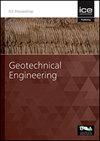在英国建筑工地遇到未爆炸炸弹的概率是多少?
IF 1.7
4区 工程技术
Q3 ENGINEERING, GEOLOGICAL
Proceedings of the Institution of Civil Engineers-Geotechnical Engineering
Pub Date : 2023-02-03
DOI:10.1680/jgeen.21.00138
引用次数: 0
摘要
定量风险数据对于有效和一致地评估风险至关重要,并允许有效地利用成本效益分析来评估缓解措施。英国境内建筑工地未爆炸炸弹(uxb)风险的定量评估涉及识别一系列促成风险因素并对它们之间的相互作用进行建模。风险因素的相互作用已经使用蒙特卡罗模拟建立了一个新的风险评估工具(JG-MCS)。介绍了该工具的一些输出结果,包括针对已发表作品可能进行的有限验证。该工具用于评估风险对某些问题变量的敏感性,并研究了几个潜在的假设。该模型还得到扩展,以探讨调查性缓解措施的影响。在本文中,就正在评估的风险、如何呈现风险以及某些缓解措施的有效性提出了一系列基本问题。对于所使用的情景,发现在缓解之前遭遇UXB的总体风险很低,而在缓解之后仅略低。研究还发现,实施措施降低uxb带来的风险的成本可能被认为低于HSE所描述的“合理可行”的范围。本文章由计算机程序翻译,如有差异,请以英文原文为准。
What is the probability of encountering unexploded bombs on a U.K. construction site?
Quantitative risk data is essential for the efficient and consistent assessment of risk and allows for the effective use of cost-benefit analysis for assessing mitigating measures. The quantitative assessment of the risk posed by unexploded bombs (UXBs) on construction sites within the U.K. involves the identification of a set of contributory risk factors and modelling the interaction between them. The interaction of the risk factors has been modelled using Monte Carlo Simulation built into a new risk assessment tool (JG-MCS). Some of the output results from the tool are presented, including the limited validation that is possible against published work. The tool is used to assess the sensitivity of risk to some of the problem variables and several of the underlying assumptions are investigated. The model has also been extended to explore the influence of investigative mitigation measures. In this paper a set of fundamental questions are raised regarding the risks being assessed, how they are presented and the efficacy of some mitigation measures. For the scenario used, it was found that the overall risk of UXB encounter was low before mitigation and only slightly lower after mitigation. It was also found that the cost of implementing measures to reduce the risk posed by UXBs might be considered to be below the bracket of what is described by the HSE as ‘reasonably practicable’.
求助全文
通过发布文献求助,成功后即可免费获取论文全文。
去求助
来源期刊
CiteScore
4.40
自引率
4.50%
发文量
68
审稿时长
3 months
期刊介绍:
Geotechnical Engineering provides a forum for the publication of high quality, topical and relevant technical papers covering all aspects of geotechnical research, design, construction and performance. The journal aims to be of interest to those civil, structural or geotechnical engineering practitioners wishing to develop a greater understanding of the influence of geotechnics on the built environment.

 求助内容:
求助内容: 应助结果提醒方式:
应助结果提醒方式:


